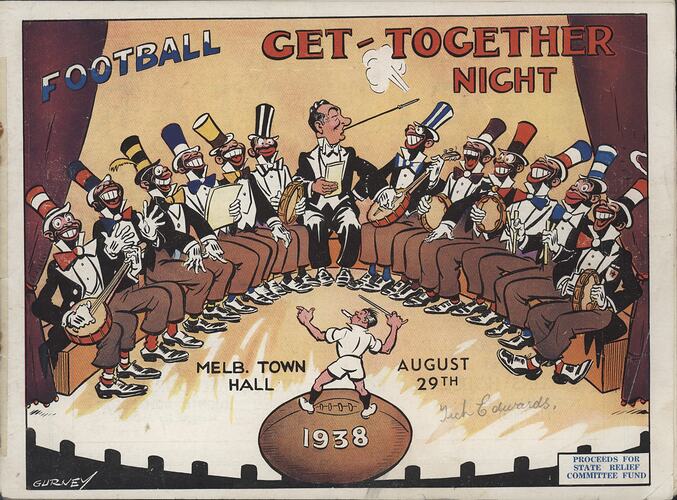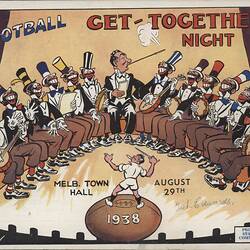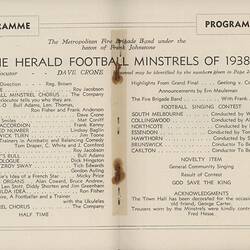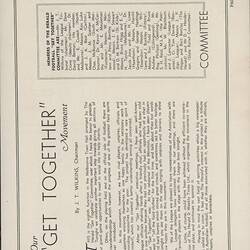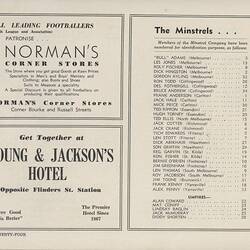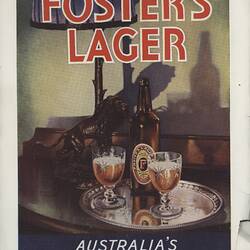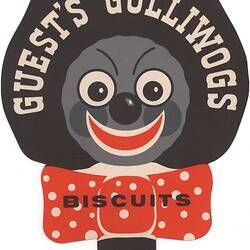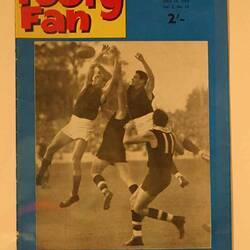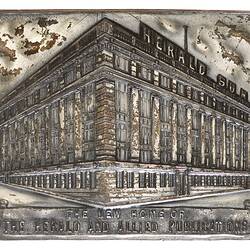Summary
Note: This object includes includes people wearing 'blackface' and a derogatory depiction of a particular cultural group. Such depictions are not condoned by Museums Victoria which considers them to be racist. Historical distance and context do not excuse or erase this fact.
Program for a 'Football Get-Together Night' held at the Melbourne Town Hall on 29 August 1938. The event was organised by the Herald & Weekly Times newspaper with proceeds going to the State Relief Committee Fund. The cover is by Bluey and Curley artist Alex Gurney and it is signed by Arthur 'Titch' Edwards, Fitzroy Football Club player at the time who also appears in one of the performance acts. The contents include advertisements for various Melbourne businesses, and a page promoting opticians Coles & Garrard with a photograph of the C&G black and white minstrels in the 3DB radio station studio. The double central page features the evening's program: 'The Herald Football Minstrels of 1938' along with the Metropolitan Fire Brigade Band. The final page includes a list of the entire Minstrel Company, including 29 football players across the two leagues and five umpires.
Physical Description
Program with full colour cover, 24 pages with 2 staples at central spine. Cover features an illustration by Alex Gurney showing a row of 12 seated black and white minstrels wearing top hats in Victorian Football League and Victorian Football Association club colours. They are playing banjos, tambourines and 'bones.' A field umpire in white acts as conductor. It is signed by Fitzroy Football Club player Arthur 'Titch' Edwards. Inside pages feature advertisements for Melbourne businesses, short articles by club representatives and a central double page with the evening's program: 'The Herald Football Minstrels of 1938.
Significance
Statement of Historical Significance:
This program provides a powerful and evocative visual example of the popularity of black and white minstrels in Australian popular culture. It also highlights the work of the State Relief Committee (now the Victorian Relief Committee) which was established by the State Government in response to the dire situation of the local population affected by the Depression. It demonstrates the co-existence of the Victorian Football League and the Victorian Football Association (formed when six teams broke away from the VFA to form the VFL in 1897) and the intertwining of sport, performance, and charity. The image on the back cover of a neon 'Vote No' sign refers to the 1938 Victorian State Parliament poll on the abolition of liquor licences.
Minstrelsy originated in the USA during the 1830s as a popular form of entertainment. White or black people (most commonly white people) would paint their faces black and through performance, present their black characters as lazy, comical and happy. Minstrelsy continued as a form of entertainment, principally in western countries, until the second half of the 20th century. Its content changed over time to reflect social happenings, such as the Abolishment Movement, the American Civil War and increased immigration to the USA. A real decline of minstrel shows occurred in the 1960s, when social movements (such as Black Power) for civil rights, race equality and political power gained momentum. The stereotype of African American culture and history developed by minstrelsy has prevailed to the present day.
Australian popular culture is full of examples of professional and amateur portrayals of black and white minstrels. Melbourne hosted the Black and White Minstrel Show during 1962, which was based on a UK BBC TV series that continued into the 1970s. Australia during the early-mid 1960s was talking about the USA Civil Rights Movement; however, it wasn't until the late 1960s, early 1970s when Australia began to make real change to its own civil rights laws governing Aboriginal peoples. Up until this time, it was quite acceptable to represent Aboriginal people in a comparable way to that of the minstrels of the USA, although their histories and happenings were completely separate. The legacy of the black minstrels continues in Australia today. For instance, in 2009, Hey Hey It's Saturday's Red Faces show hosted a comic skit called the Jackson Jive. Its participants danced around with their faces painted black, wearing fuzzy black wigs on their head; the sketch drew laughter from audience members but was broadly criticised by both the guest, American singer Harry Connick Junior, and subsequent local and international commentators.
More Information
-
Collecting Areas
-
Acquisition Information
Purchase
-
Organisation Named
State Relief Committee, Government of Victoria, Melbourne, Greater Melbourne, Victoria, Australia, 29 Aug 1938
-
Organiser of Event
Victorian Football League, Melbourne, Victoria, Australia, 1938
-
Sponsor
Herald & Weekly Times Ltd., Melbourne, Victoria, Australia, 1938
-
Inscriptions
Front cover: 'FOOTBALL GET-TOGETHER NIGHT / MELB. TOWN HALL / AUGUST 29TH / 1938 / PROCEEDS FOR STATE RELIEF COMMITTEE FUND.' Signed bottom left corner: 'GURNEY.' Autographed: 'Tich Edwards.'
-
Classification
-
Category
-
Discipline
-
Type of item
-
Overall Dimensions - Closed
250 mm (Width), 185 mm (Height)
-
Keywords
Football, Sporting Memorabilia, Sporting Teams, Cultural Stereotypes, Performances
